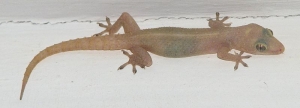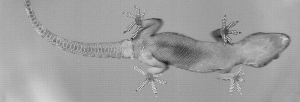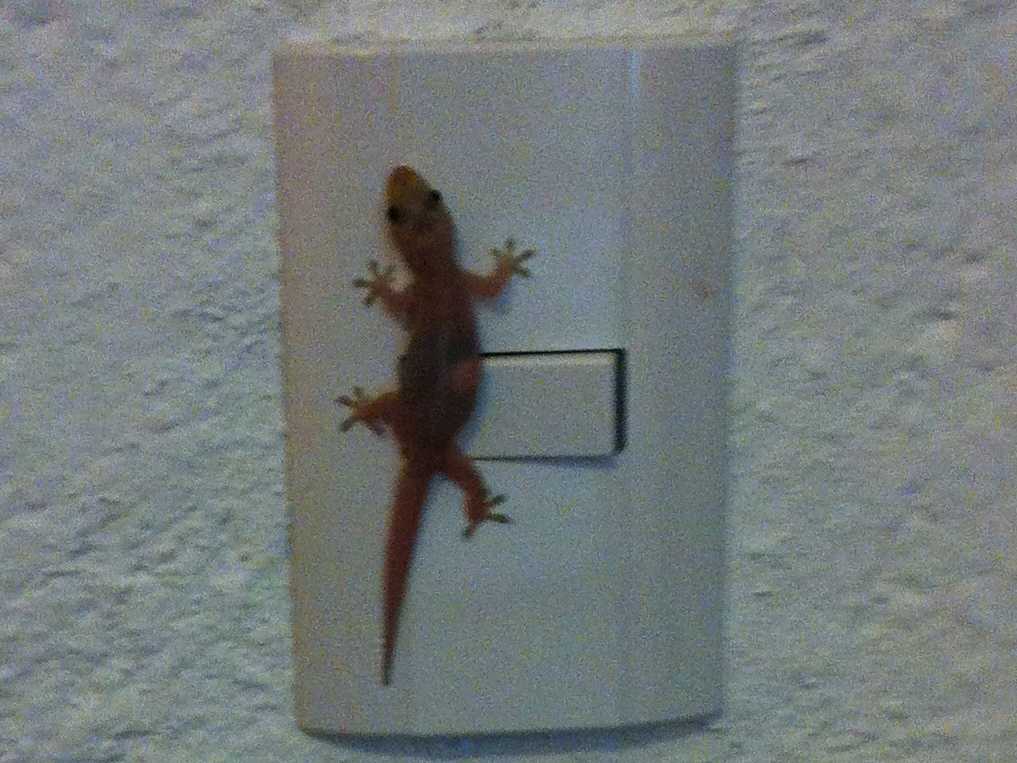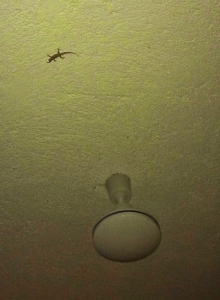“That’s really a pretty cute trick,” I said to myself.
What sort of surprised me was that I was saying anything to anyone at all, including myself. Susan and I had just watched a World Cup soccer match in a thatched palapa bar here in Akumal, Mexico, then walked a mile and a half home, and if the heat was an unprovoked assault, the humidity was a crime against humanity. With three margaritas in me and drenched in sweat, I burst into the bedroom and groped for the air conditioner like a poisoned man groping for the antidote, and then we both fell backwards onto the bed—and then this little gecko ran across the ceiling above my face.
Between the gecko and my face whirled the scythe-like blades of a ceiling fan, in a sinister blur. Losing her grip would have been a scene from a grade-B gecko gore movie, but she was nonchalantly confident, and scampered upside-down all the way across the painted concrete ceiling to the wall, then transitioned fluidly to the vertical surface, and disappeared into her hidey hole behind the valance of the window blind. Okay, I said, still managing somehow to converse with myself. I have to find out how they do that.
Just as soon as the temperature in here drops by twenty degrees.
Like most times I’ve ended up reading something astonishing, the reason I wanted to know more was that I already knew a little. I knew that they do not do this with claws, they do not do it with suction cups, they do not do it with a goopy adhesive substance, and they are not affected by the smoothness or roughness of the surface. What the hey? I started reading.

-
A better shot of a house gecko
By Praveenp[CC BY-SA 3.0], via Wikimedia CommonsIf we’ve ID’d her correctly, she’s commonly called the house gecko (Hemidactylus frenatus), and I call her a she because she barks at night. I kid you not. It took us forever to figure out what that sound was. It’s a female house gecko advertising for a mate. But something Susan found out in her research is that she doesn’t need a mate. The house gecko doesn’t, I mean. The house gecko is parthenogenic, meaning that the female is capable of making babies without the help of a male. That’s also a very cute trick, but actually she only does it in a pinch, because when you do that, genetic diversity suffers. In case you don’t remember your high school Darwinian evolution, or in case they’re not teaching it anymore, sex is all about diversity. Diversity is the only reason you have a sex life. You don’t want all your kids to be carbon copies of yourself, because if your environment throws you a curve ball, you want some of your kids to be weirdos, because there’s a chance the weirdo might be able to handle the change. Which is probably the only reason I’m on the planet.
Everyone around here loves having a gecko in their house, and we are blessed with either a couple of them, or with one who is very mobile, I haven’t figured out which yet. The reason people love them is that they eat bugs, and the bugs down here in the tropics are, well, let’s just say the potential subject of several future Ranger Randy articles. In Spanish, house geckos are called limpia casas—house cleaners. They can eat a spider twice the size of their head, and I just love that about them. For Susan’s part, she loves that they eat mosquitos.
They’re pretty small lizards. They only get about as long as your finger, but they leave huge droppings, and Susan and I thought we had rats in the house, which are not a part of the natural wonderland we wanted to invite into our living space. The property caretaker, Rene, had to convince us that they were gecko droppings.
Even this fascinated me. Like any self-respecting naturalist, I like turds. Okay, the field of study is actually called scatology, but I don’t mince words for my readers—we naturalists like turds. There is a lot of information in their contents, and there is a lot of information in their abundance, location and distribution, and the really cool thing about them is that they don’t run, they don’t hide, and they don’t bite. Turds are great sources of information, and there’s not a wildlife biologist anywhere who is at all shy about working with them. And actually, I had already noticed that these had one white end, which means that you’re dealing with an animal who does not urinate. The white is uric acid. That usually means a bird or a reptile. So I was easily convinced that we had geckos and not rats. (But good heavens, the size of those things! Ow!)
* * * *
So now I’m remembering my father in one of our late-night debates (and we had a lot of them) and he’s saying, “We must remember that nature is not divided into disciplines the way universities are.” It was one of his favorite quotes, and what’s annoying me as I write this is that I can’t remember which famous scientist he attributed it to, and now, even with all the power of the Internet at my fingertips, I can’t for the life of me find it, so if anyone out there can source that quote, please email me, because I’m dying to remember. Maybe an attribution doesn’t exist and it’s one of those quotes that came from no one in particular. It doesn’t matter, they are profoundly wise words, and sure enough, when I looked into this anti-grav thing that geckos do, the biology of it took me straight into physics.
There is a very faint and feeble force in physics called the van der Waals force, and even if you are a scientist, it might not be a force you hear very much about. It does hold molecules together, sort of, but it is not to be confused with the irrevocable force of a chemical bond, which results from something slam-clank solid like an electron shared between two positively charged nuclei, and is bomb-proof and almost impossible to break. No, the van der Waals force is a ghost of a force compared to that. I’m not really qualified to explain it to you, but it has to do with the charge fluctuations of molecules naturally falling into sync and creating a tiny attraction. It is incredibly subtle, but it is the reason that if you get any two molecules in this universe close enough to each other, they will be slightly attracted to each other. It is weak and easily disrupted and easily overpowered, but it is there, and if it were not there, you would not recognize this place. Without the van der Waals force, water vapor would not condense into either liquid or ice. Without it, there would be no crystalline structures—no snowflakes, no quartz. It is the reason water has surface tension, and without it there would be no such thing as a droplet. It is the reason we have melting points and boiling points, and it makes possible gigantic molecules like enzymes, and DNA. Without the van der Waals force, life as we know it would not be possible, and it is the reason geckos stick to the ceiling.
We don’t feel the van der Waals force when we touch a wall because on the microscopic level so little of our body is actually in contact with it. There is the shape of our hand, the roughness of our skin, the way the two shapes do not conform to each other. Down there on the molecular level, very, very few person molecules are actually touching wall molecules. That’s the problem the geckos solved. So I’m going to take you on a zoom-in, a big one. Hang onto you chair…
First of all, let’s zoom in on the bottoms of those cute little club-shaped toes that geckos have. The bottoms of those toes are plated like the treads of a caterpillar tractor so that they can roll on and off of a surface incrementally and fluidly. More on that in a bit.

-
A gecko shows off her laminellae (Click to enlarge)
By ZooFari [CC BY-SA 3.0], via Wikimedia Commons
Zooming in on one of those plates (called laminellae), we find that it is covered with tiny hairs, and each hair is pretty short, but there are a ton of them—up to 1,400 per square millimeter. Let’s zoom in more:
On the end of each single hair (called a settae) there are, I kid you not, up to 1,000 little pads called spatulae, and each one is only 200 nanometers wide. Now, to give you an idea of where we are at this point in our zoom, a nanometer (nm) is a billionth of a meter. So these structures with which our little gecko finally makes physical contact with the painted concrete of my ceiling are actually smaller than the wavelength of visible light.
The end result? There is no part of any surface this gecko walks on that gets missed by this set-up. She has maximized her surface area to an incredible extent. She is playing touchy-feely with our ceiling at almost the molecular level. That feeble little van der Waals force has become a rock-solid bond. She has no fear. She will never fall.
In fact, it works so well that she actually has adhesion to spare. Evolution did have to over-build her a little bit. After all, she lives a fairly complicated life, and as she moves around, not all those little structures are in contact with the wall all the time—in fact, not even all four of her feet are on the wall all the time. So at any given moment, she’s only using a fraction of her adhesion capability. But scientists love to run theoretical numbers. They estimate that if you could set up an ideal situation and get every spatulae she owns on the ceiling at the same time, you could hang 293 pounds from that little lizard.
Which left her—or at any rate her ancestors—with an interesting problem that had to be solved as this thing evolved. If you took your average appendage—say a human hand—and covered it with those spatulae and setae and slapped it on the wall, you’d never get it off. You’d still be tugging at it. And that’s why geckos’ feet have that unusual anatomy I mentioned. Everything happens on those little tractor-tread plates, and her toes are double jointed—that is, the knuckles can bend backwards (it’s actually called digital hyperextension), so she is able to roll her toes off the wall.
When this van der Waal angle started to become apparent to researchers (only a decade or so ago), technology began to imitate nature. A team at Simon Fraser University in British Columbia has built a robot inspired by the gecko. Sure enough, it’s on tractor treads. They have managed to create artificial setae out of a material called PDMS whose real name I don’t have room to type here, and this thing can climb walls wet or dry, smooth or rough. They’ve already got the prototype working. You can watch it below:
A team at Northwestern University in Evanston, Illinois is creating a tape called Geckel, which will work wet or dry, smooth or rough, and won’t wear out for a thousand or more uses. They’re picturing medical applications for it, like a replacement for sutures which is impervious, just like sutures are, to water and other conditions.
All of which is very cool, but before I shell out for one of those robots, they’re going to have to teach it how to eat spiders.
Now you know.
Copyright © 2014 Randy Fry



Isaac Asimov is quote source. Thanks for the incredible info!